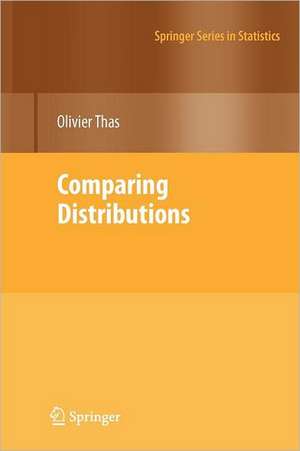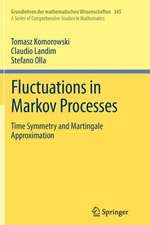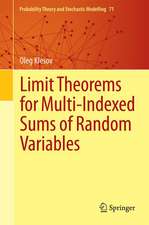Comparing Distributions: Springer Series in Statistics
Autor Olivier Thasen Limba Engleză Paperback – 25 feb 2012
This book consists of two parts. In the first part statistical methods for the one-sample problem are discussed. The second part of the book treats the K-sample problem. Many sections of this second part of the book may be of interest to every statistician who is involved in comparative studies.
The book gives a self-contained theoretical treatment of a wide range of goodness-of-fit methods, including graphical methods, hypothesis tests, model selection and density estimation. It relies on parametric, semiparametric and nonparametric theory, which is kept at an intermediate level; the intuition and heuristics behind the methods are usually provided as well. The book contains many data examples that are analysed with the cd R-package that is written by the author. All examples include the R-code.
Because many methods described in this book belong to the basic toolbox of almost every statistician, the book should be of interest to a wide audience. In particular, the book may be useful for researchers, graduate students and PhD students who need a starting point for doing research in the area of goodness-of-fit testing. Practitioners and applied statisticians may also be interested because of the many examples, the R-code and the stress on the informative nature of the procedures.
Din seria Springer Series in Statistics
- 14%
 Preț: 679.60 lei
Preț: 679.60 lei - 20%
 Preț: 630.97 lei
Preț: 630.97 lei - 20%
 Preț: 816.43 lei
Preț: 816.43 lei - 20%
 Preț: 1000.84 lei
Preț: 1000.84 lei -
 Preț: 390.84 lei
Preț: 390.84 lei - 20%
 Preț: 697.13 lei
Preț: 697.13 lei - 20%
 Preț: 445.20 lei
Preț: 445.20 lei - 20%
 Preț: 881.51 lei
Preț: 881.51 lei - 18%
 Preț: 1237.14 lei
Preț: 1237.14 lei - 18%
 Preț: 967.22 lei
Preț: 967.22 lei - 18%
 Preț: 956.50 lei
Preț: 956.50 lei - 18%
 Preț: 794.25 lei
Preț: 794.25 lei - 15%
 Preț: 648.05 lei
Preț: 648.05 lei - 18%
 Preț: 1222.49 lei
Preț: 1222.49 lei - 15%
 Preț: 646.11 lei
Preț: 646.11 lei - 15%
 Preț: 647.08 lei
Preț: 647.08 lei - 15%
 Preț: 646.11 lei
Preț: 646.11 lei - 18%
 Preț: 1389.62 lei
Preț: 1389.62 lei - 15%
 Preț: 652.81 lei
Preț: 652.81 lei - 18%
 Preț: 1114.52 lei
Preț: 1114.52 lei - 18%
 Preț: 952.40 lei
Preț: 952.40 lei - 18%
 Preț: 1393.27 lei
Preț: 1393.27 lei - 18%
 Preț: 1561.68 lei
Preț: 1561.68 lei - 18%
 Preț: 1231.47 lei
Preț: 1231.47 lei - 15%
 Preț: 513.64 lei
Preț: 513.64 lei - 18%
 Preț: 893.71 lei
Preț: 893.71 lei - 15%
 Preț: 649.87 lei
Preț: 649.87 lei - 18%
 Preț: 1007.65 lei
Preț: 1007.65 lei - 18%
 Preț: 1111.67 lei
Preț: 1111.67 lei - 18%
 Preț: 1229.10 lei
Preț: 1229.10 lei - 18%
 Preț: 892.74 lei
Preț: 892.74 lei - 18%
 Preț: 913.26 lei
Preț: 913.26 lei - 18%
 Preț: 943.88 lei
Preț: 943.88 lei -
 Preț: 391.61 lei
Preț: 391.61 lei -
 Preț: 391.22 lei
Preț: 391.22 lei - 18%
 Preț: 1391.04 lei
Preț: 1391.04 lei -
 Preț: 390.84 lei
Preț: 390.84 lei - 18%
 Preț: 893.84 lei
Preț: 893.84 lei - 18%
 Preț: 960.61 lei
Preț: 960.61 lei - 18%
 Preț: 1245.34 lei
Preț: 1245.34 lei - 18%
 Preț: 964.54 lei
Preț: 964.54 lei - 15%
 Preț: 643.16 lei
Preț: 643.16 lei - 18%
 Preț: 1674.70 lei
Preț: 1674.70 lei - 15%
 Preț: 643.84 lei
Preț: 643.84 lei - 15%
 Preț: 586.37 lei
Preț: 586.37 lei - 18%
 Preț: 1004.99 lei
Preț: 1004.99 lei - 15%
 Preț: 643.34 lei
Preț: 643.34 lei - 18%
 Preț: 806.40 lei
Preț: 806.40 lei - 18%
 Preț: 727.66 lei
Preț: 727.66 lei
Preț: 644.30 lei
Preț vechi: 758.01 lei
-15% Nou
Puncte Express: 966
Preț estimativ în valută:
123.30€ • 127.95$ • 103.06£
123.30€ • 127.95$ • 103.06£
Carte tipărită la comandă
Livrare economică 15-29 martie
Preluare comenzi: 021 569.72.76
Specificații
ISBN-13: 9781461424499
ISBN-10: 1461424496
Pagini: 376
Ilustrații: XVI, 354 p.
Dimensiuni: 155 x 235 x 20 mm
Greutate: 0.53 kg
Ediția:2010
Editura: Springer
Colecția Springer
Seria Springer Series in Statistics
Locul publicării:New York, NY, United States
ISBN-10: 1461424496
Pagini: 376
Ilustrații: XVI, 354 p.
Dimensiuni: 155 x 235 x 20 mm
Greutate: 0.53 kg
Ediția:2010
Editura: Springer
Colecția Springer
Seria Springer Series in Statistics
Locul publicării:New York, NY, United States
Public țintă
ResearchCuprins
One-Sample Problems.- Preliminaries (Building Blocks).- Graphical Tools.- Smooth Tests.- Methods Based on the Empirical Distribution Function.- Two-Sample and K-Sample Problems.- Preliminaries (Building Blocks).- Graphical Tools.- Some Important Two-Sample Tests.- Smooth Tests.- Methods Based on the Empirical Distribution Function.- Two Final Methods and Some Final Thoughts.
Recenzii
From the reviews:
“Comparing distributions means mainly goodness-of-fit testing. … A lot of details are cited from the huge reference list, which I like very much. … At the end of the sections some practical guidelines are given which are very helpful. The monograph is of interest for applied statisticians as well as for research mathematicians. It contains a good overview of tests and methods. It can be recommended for advanced seminars on testing. … I can warmly recommend it.” (Arnold Janssen, Mathematical Reviews, Issue 2010 k)
“This outstanding book is about goodness of fit (GOF) testing … . In addition the book presents some graphical tools for comparing distributions with its focus on graphs that are closely related to statistical tests. … The book contains some theory with numerous examples that are useful for both applied statisticians and nonstatistician practitioners. … In conclusion this book provides considerable information for a wide range of Technometrics readers and it is a valuable contribution to our profession.” (Subir Ghosh, Technometrics, Vol. 53 (1), February, 2011)
“Comparing distributions means mainly goodness-of-fit testing. … A lot of details are cited from the huge reference list, which I like very much. … At the end of the sections some practical guidelines are given which are very helpful. The monograph is of interest for applied statisticians as well as for research mathematicians. It contains a good overview of tests and methods. It can be recommended for advanced seminars on testing. … I can warmly recommend it.” (Arnold Janssen, Mathematical Reviews, Issue 2010 k)
“This outstanding book is about goodness of fit (GOF) testing … . In addition the book presents some graphical tools for comparing distributions with its focus on graphs that are closely related to statistical tests. … The book contains some theory with numerous examples that are useful for both applied statisticians and nonstatistician practitioners. … In conclusion this book provides considerable information for a wide range of Technometrics readers and it is a valuable contribution to our profession.” (Subir Ghosh, Technometrics, Vol. 53 (1), February, 2011)
Textul de pe ultima copertă
Comparing Distributions refers to the statistical data analysis that encompasses the traditional goodness-of-fit testing. Whereas the latter includes only formal statistical hypothesis tests for the one-sample and the K-sample problems, this book presents a more general and informative treatment by also considering graphical and estimation methods. A procedure is said to be informative when it provides information on the reason for rejecting the null hypothesis. Despite the historically seemingly different development of methods, this book emphasises the similarities between the methods by linking them to a common theory backbone.
This book consists of two parts. In the first part statistical methods for the one-sample problem are discussed. The second part of the book treats the K-sample problem. Many sections of this second part of the book may be of interest to every statistician who is involved in comparative studies.
The book gives a self-contained theoretical treatment of a wide range of goodness-of-fit methods, including graphical methods, hypothesis tests, model selection and density estimation. It relies on parametric, semiparametric and nonparametric theory, which is kept at an intermediate level; the intuition and heuristics behind the methods are usually provided as well. The book contains many data examples that are analysed with the cd R-package that is written by the author. All examples include the R-code.
Because many methods described in this book belong to the basic toolbox of almost every statistician, the book should be of interest to a wide audience. In particular, the book may be useful for researchers, graduate students and PhD students who need a starting point for doing research in the area of goodness-of-fit testing. Practitioners and applied statisticians may also be interested because of the many examples, the R-code and the stress on the informative nature of the procedures.
Olivier Thas is Associate Professor of Biostatistics at Ghent University. He has published methodological papers on goodness-of-fit testing, but he has also published more applied work in the areas of environmental statistics and genomics.
This book consists of two parts. In the first part statistical methods for the one-sample problem are discussed. The second part of the book treats the K-sample problem. Many sections of this second part of the book may be of interest to every statistician who is involved in comparative studies.
The book gives a self-contained theoretical treatment of a wide range of goodness-of-fit methods, including graphical methods, hypothesis tests, model selection and density estimation. It relies on parametric, semiparametric and nonparametric theory, which is kept at an intermediate level; the intuition and heuristics behind the methods are usually provided as well. The book contains many data examples that are analysed with the cd R-package that is written by the author. All examples include the R-code.
Because many methods described in this book belong to the basic toolbox of almost every statistician, the book should be of interest to a wide audience. In particular, the book may be useful for researchers, graduate students and PhD students who need a starting point for doing research in the area of goodness-of-fit testing. Practitioners and applied statisticians may also be interested because of the many examples, the R-code and the stress on the informative nature of the procedures.
Olivier Thas is Associate Professor of Biostatistics at Ghent University. He has published methodological papers on goodness-of-fit testing, but he has also published more applied work in the areas of environmental statistics and genomics.















